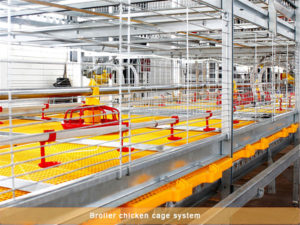Farmers can choose whether to raise laying hens or broilers according to their own conditions and the difference between laying hens and broilers, but large-scale breeding is indispensable because it can better manage the chickens in the battery cage for broilers.
The raising efficiency of broilers depends on the slaughter rate and feed-to-meat ratio of broilers. In order to realize the efficient raising of broilers, that is, to achieve the ideal slaughter rate and feed-to-meat ratio, the following points should be done in practice.
Choose good varieties suitable for local breeding. Control the appropriate density, temperature and humidity ① Density: 8 ~ 10 animals can be raised per square meter in summer; 13 animals per square meter in winter and spring; Farm chicken farms generally have 35 square meters of houses for 400 to 500 broilers. (2) temperature: it is advisable to start the indoor temperature at 32℃ ~ 34℃, and keep good ventilation, drying and cleaning conditions. (3) Humidity: The relative humidity in the chicken coop should be kept at 60% ~ 70% during the hatchling period, and that of the medium chicks should be kept at 50% ~ 60%. Attention should be paid to keeping the ground of the chicken coop dry and the humidity suitable, and the drinking water appliance should be placed in a suitable position.

Strengthen the sanitary management and scientific breeding of poultry farming equipment, and adopt the method of open ground flat breeding, free feed intake and all-in and all-out for meat chickens. For the first batch, especially the second batch and later batches of chickens, the walls, floors, feeding utensils and bedding of the chicken coop must be thoroughly disinfected according to the disinfection operation procedures before they are fed in the chicken coop, and the bedding must be replaced regularly. (2) the chicken coop should keep sufficient light. No matter what kind of chicken coop, 24 hours of light should be used before 3 days of age, 18 hours of light every day after 3 days of age, half an hour a week, gradually approaching natural light. (3) regular ventilation. Ventilation is to ensure fresh indoor air. Due to the high body temperature of chickens, the maximum air exchange rate per kilogram of body weight reaches 4.5 cubic meters per hour, and the air exchange rate in summer is about 4 times that in winter. (4) Ensure sufficient clean drinking water. Reasonable material selection according to different growth days. Do a good job in the prevention, control and treatment of diseases. Vaccinate chickens in the breeding equipment in a timely manner, and seize the opportunity to be released at the right time. The market price of broilers when they are released from the market has a great influence on the economic benefits of broiler rearing.